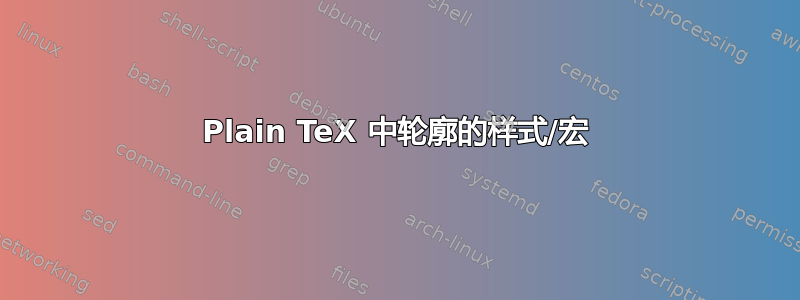
我正在寻找一个样式文件或其他宏,用于在 Plain TeX 中创建传统缩进样式的轮廓,例如。
I. Big Idea
A. Sub idea
B. Sub idea
1. Thought
a. Sub thought
如果还没有人这样做,并且如果有人有兴趣合作,我很乐意(有一天)写一个。
答案1
答案2
由于我对找到的任何 Plain TeX 宏都不满意,而且 1991 年的旧宏要么被删除,要么被移动(链接失效),所以我最终编写了自己的宏,如下所示。这些宏不适用于 LaTeX。结果如下所示:
宏的末尾有一个示例大纲。
%
% Plain TeX macros to create simple outlines, texoutlines.tex
% C. Kelly, 2016
%
\def\outlinebeg{\parindent=1.5em\obeylines\bigbreak\leftline{\bf Outline}\smallskip\hrule\smallskip}
% Two versions of this macro, the second inserts an \hrule
\def\outlineend{\smallskip\bigskip}
%\def\outlineend{\smallskip\hrule\bigskip}
% Use \outlinefile to read a file with the outline
\def\outlinefile#1\par{\bgroup\outlinebeg\input#1\outlineend\egroup}
% Use \outline to read outline until the first \par
\def\outline#1\par{\bgroup\outlinebeg#1\outlineend\egroup}
% With these, you should provide either "." or "I.", "A.", etc, as you prefer.
% They don't increment automatically.
\def\I#1.{\medskip\goodbreak\hang\noindent{#1.}}
\def\2#1.{\par\indent \hangindent2\parindent \textindent{#1.}}
\def\3#1.{\par\indent\indent \hangindent3\parindent \textindent{#1.}}
\def\4#1.{\par\indent\indent\indent \hangindent4\parindent \textindent{#1.}}
\def\5#1.{\par\indent\indent\indent\indent \hangindent5\parindent \textindent{#1.}}
% Following are new macros which don't require you to provide the outline item number
\def\letter#1{\ifcase#1\or a\or b\or c\or d\or e\or f\or g\or h\or i\or j\or
k\or l\or m\or n\or o\or p\or q\or r\or s\or t\or u\or v\or w\or
x\or y\or z\or aa\or bb\or cc\or dd\or ee\or ff\or gg\or hh\or ii\or
jj\or kk\or ll\or mm\or nn\or oo\or pp\or qq\or rr\or ss\or tt\or
uu\or vv\or ww\or xx\or yy\or zz\else$\dots$\fi}
\newcount\cnta \cnta=0
\newcount\cntb \cntb=0
\newcount\cntc \cntc=0
\newcount\cntd \cntd=0
\newcount\cnte \cnte=0
\def\A{\global\advance\cnta by 1
\medskip\goodbreak\hang\noindent{\uppercase\expandafter
{\romannumeral\cnta}. }
\cntb=0 \cntc=0 \cntd=0 \cnte=0
}
\def\b{\global\advance\cntb by 1
\par\indent \hangindent2\parindent \textindent
{\uppercase\expandafter{\letter\cntb}. }
\cntc=0 \cntd=0 \cnte=0
}
\def\c{\global\advance\cntc by 1
\par\indent\indent \hangindent3\parindent \textindent
{\number\cntc. }
\cntd=0 \cnte=0
}
\def\d{\global\advance\cntd by 1
\par\indent\indent\indent \hangindent4\parindent \textindent
{\letter\cntd. }
\cnte=0
}
\def\e{\global\advance\cnte by 1
\par\indent\indent\indent\indent \hangindent5\parindent \textindent
{\romannumeral\cnte. }
}
\let\i\e
\def\f{
\par\indent\indent\indent\indent\indent \hangindent6\parindent \textindent
{ $\bullet$ }
}
%
% Macros to create outlines {END}
\endinput
% A sample usage of the above macros
\outline % new style
\A Example using newer macros
\b Lorem ipsum dolor sit amet, consectetur adipiscing elit, sed do eiusmod tempor
\c incididunt ut labore et dolore magna aliqua. Ut enim ad minim veniam, quis nostrud exercitation ullamco laboris nisi ut aliquip ex ea commodo consequat.
\d Duis aute irure dolor
\e Freedom \dots from what?
\5. from having to have a number in this point. This is using the old-style macro
\f At this level, we just want bullets
\e Something more
\e And another thing\dots
\b What can be said more
\c New point 1
\c Yet another point
\noindent Note that a blank line ends the outline
but the counters are not reset until a new {\tt\char`\\ outline} is
declared. So if you have something more to put into your outline,
just do so.
\A New point here.
\b New subpoints
\outline % old style
\I . Example outline with older macros
\I I. Big heading
\2 A. Subhead
\2 B. Subhead
\3 1. Sub-subhead
\3 2. Sub-subhead
\4 a. Sub-sub-subhead
\4 b. Sub-sub-subhead
\5 i. sub-sub-sub-subhead
\5 ii. sub-sub-sub-subhead
\5 . Unlabeled sub-sub-sub-subhead
\3 4. Next Sub-subhead. (oops! I skipped 3.)
\I II. New major head
%You can also insert a file with an outline in it, with \outlinefile
\outlinefile file_with_my_outline.txt
% Sample input, end
\vfill\eject\end



